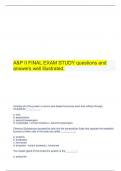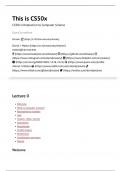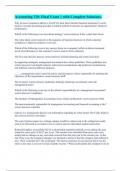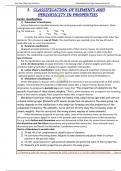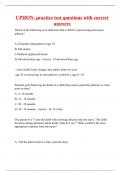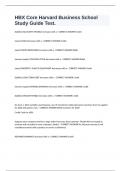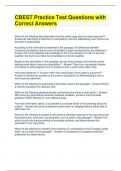INTEGRATED REGENERATIVE DESIGN
LES 1
1. Sustainability is not enough
1.1. Introduction
We did too little too late, these facts will change our life forever. But which side
are you on? The side of the deniers? And what about activism?
1.2. Take what you need
For free
We take more than we need and never give anything back
We use our planet on a daily basis: energy, materials, food, space, fresh air…
What if each extraction means less planet? Then our future is self-destruction
1.3. Produce and create a market to sell
As cheap as possible
Many people work for too low wages => as cheap as
possible
1.4. Consume
As fast as possible
We make products that break down quickly. This allow us to sell more
We dump cheap products in the market in large numbers. Fast consumption is the
emphasis.
1.5. Bad design quickly becomes a waste
Dump waste as cheaply as possible
Our earth becomes a giant wasteland. We dump literally everything in our
environment
What we have to offer the planet: waste, pollution, CO2, and foreign substances
that unbalance nature. => mass consumption is killing the planet.
The construction industry is the biggest polluter. Waste is an important part of
building.
The disrespectful exploitation of our earth causes an ecological catastrophe. We
live in a landfill.
1.6. The limits to growth, 1972
Club of Rome
The reported discussed the possibility of exponential economic and population
growth with finite supply of resources
Since the report limits to growth we are increasingly aware of the fact that our
way of life is damaging our planet.
What we ask for on daily basis is no longer balanced with the capacity of our
planet.
,1.7. Our footprint is too big
We consume too much and too fast
Our ecological footprint is indicating that the pressure on our planet is
unacceptably high. Year after year it is still growing.
Earth overshootday
1.8. Our climate is changing
We are leaving the once save
conditions
Our earth is a miracle in the
cosmos. Not for us, it is a daily
bin. We are mass dumping CO2.
The earth becomes an
unpleasant greenhouse.
Since 1968 we have started to
look more closely at our own planet. Earthrise changed the world forever.
Change happens too slow and too late
Our lives themselves are harmful to this planet. The damage we do changes the
planet.
More and more zones are becoming uninhabitable. We can look ahead and
anticipate what changes locally.
But what if our earth no longer supported our lives? => more and more places
become definitively uninhabitable
If we do not stop the warming, more and more zones will become uninhabitable.
Unseen migration will be needed.
Humans have adapted to live in a narrow band of environmental and climatic
fluctuations, but temperature rises threaten this.
1.9. Sustainability failed
Less bad is not good enough
We lost 50 years. We know what to do. Moving on is a
slow suicide. The next few years are crucial for
humanity.
Less bad is not good enough
Sustainability is viewed as less bad. A vision that falls
short.
We need to design systems that reduce harm and also regenerate and restore the
natural environment and human well being.
Sustainability failed => the overall impact is still negative
Beyond sustainability: Replacing sustainability with Regenerative Design. The road
from sustainability to regenerative design is depicted in the diagram. On this
graph, we’re getting close to the moment where we switch from doing “less
, terrible” to “doing good.” Before we can routinely adopt regenerative design, we
have a long way to go and much to learn, and it will be a slow process.
1.10. Conclusion
Sustainability is not enough
A more holistic and regenerative approach may be necessary to create lasting
change.
What if everything we do means less planet? Then our future is self-destruction
2. There is hope => re-imagine the future
2.1. Introduction – regenerative design
We must shift to regenerative cultures.
A regenerative human culture is healthy, resilient and adaptable, it cares for the
planet, and it cares for life in the awareness that this is the most effective way to
create a thriving future for all of humanity.
Regenerative design = process-oriented systems theory-based approach to design.
Processes that restore, renew or revitalize their own sources of energy and
materials, creating sustainable systems that integrate the needs of society with
the integrity of nature. The basis is derived from systems ecology with a closed
loop input–output model or a model in which the output is greater than or equal
to the input with all outputs viable and all inputs accounted for. The model is
meant to be applied to many different aspects of human habitation such as urban
environments, buildings, economics, industry and social systems.
Kate Raworth from doughnut economics explains for us regenerative by design
=> introduces the concept of regenerative and distributive design = heart of
doughnut economics.
• Case study – a regenerative project
Can we shift from destruction to regeneration.
What if we only do good for our planet? Design positive for our living planet.
The Cheonggyecheon project in Seoul gave a certain answer to the controversial
debate in urban planning between those who believe the city should be more
, pedestrian friendly. The Cheonggyecheon river restoration project represents the
dramatic transformation of a gigantic infrastructure in the capital Seoul of Korea.
This project created a new
appearance for the city, supported
ecological development and
contributed to a better scenario for
urban mobility and quality of urban
life. The Seoul Metropolitan
Government has brought the back
Cheonggyecheon river into the daily
life of Seoul citizens after nearly 44
years of abandonment under the
highway. Today, the number of
vehicles in Seoul is markedly
reduced, making room for nature and urban facilities serving 90.000 pedestrian.
The Cheonggyecheon restoration project was
centered on revitalizing the Cheonggyecheon Stream
that had been covered for decades by a highway
overpass. The city of Seoul used its own resources to
bring new life to the downtown by enhancing the
urban environment. The restoration of the
Cheonggyecheon Stream led to the revitalization of
central Seoul, unleashing the potential for green
public space.
• What if we only do good for our planet?
Design positive for our living planet
Why not challenge designers, technologists, policymakers and planning
professionals to evaluate their proposed actions on their positive, life-sustaining,
restorative and regenerative potential?
A design without a proposal with a positive handprint to nature, the community
or the environment fails.
Compensate your footprint
• What if we embrace nature?
Can we shift from Ego-systems
Our future depends on our vision of nature. Nature does not belong to any other
world outside of us. Nature, that’s us. Nature is outside of us but also within us.
In every project we have to respect nature but above all give it many
opportunities.
It’s abnormal that we receive so much free from nature and do nothing back.
Can we stop the destruction and create space for living processes that support
our planet instead of destroying it?
LES 1
1. Sustainability is not enough
1.1. Introduction
We did too little too late, these facts will change our life forever. But which side
are you on? The side of the deniers? And what about activism?
1.2. Take what you need
For free
We take more than we need and never give anything back
We use our planet on a daily basis: energy, materials, food, space, fresh air…
What if each extraction means less planet? Then our future is self-destruction
1.3. Produce and create a market to sell
As cheap as possible
Many people work for too low wages => as cheap as
possible
1.4. Consume
As fast as possible
We make products that break down quickly. This allow us to sell more
We dump cheap products in the market in large numbers. Fast consumption is the
emphasis.
1.5. Bad design quickly becomes a waste
Dump waste as cheaply as possible
Our earth becomes a giant wasteland. We dump literally everything in our
environment
What we have to offer the planet: waste, pollution, CO2, and foreign substances
that unbalance nature. => mass consumption is killing the planet.
The construction industry is the biggest polluter. Waste is an important part of
building.
The disrespectful exploitation of our earth causes an ecological catastrophe. We
live in a landfill.
1.6. The limits to growth, 1972
Club of Rome
The reported discussed the possibility of exponential economic and population
growth with finite supply of resources
Since the report limits to growth we are increasingly aware of the fact that our
way of life is damaging our planet.
What we ask for on daily basis is no longer balanced with the capacity of our
planet.
,1.7. Our footprint is too big
We consume too much and too fast
Our ecological footprint is indicating that the pressure on our planet is
unacceptably high. Year after year it is still growing.
Earth overshootday
1.8. Our climate is changing
We are leaving the once save
conditions
Our earth is a miracle in the
cosmos. Not for us, it is a daily
bin. We are mass dumping CO2.
The earth becomes an
unpleasant greenhouse.
Since 1968 we have started to
look more closely at our own planet. Earthrise changed the world forever.
Change happens too slow and too late
Our lives themselves are harmful to this planet. The damage we do changes the
planet.
More and more zones are becoming uninhabitable. We can look ahead and
anticipate what changes locally.
But what if our earth no longer supported our lives? => more and more places
become definitively uninhabitable
If we do not stop the warming, more and more zones will become uninhabitable.
Unseen migration will be needed.
Humans have adapted to live in a narrow band of environmental and climatic
fluctuations, but temperature rises threaten this.
1.9. Sustainability failed
Less bad is not good enough
We lost 50 years. We know what to do. Moving on is a
slow suicide. The next few years are crucial for
humanity.
Less bad is not good enough
Sustainability is viewed as less bad. A vision that falls
short.
We need to design systems that reduce harm and also regenerate and restore the
natural environment and human well being.
Sustainability failed => the overall impact is still negative
Beyond sustainability: Replacing sustainability with Regenerative Design. The road
from sustainability to regenerative design is depicted in the diagram. On this
graph, we’re getting close to the moment where we switch from doing “less
, terrible” to “doing good.” Before we can routinely adopt regenerative design, we
have a long way to go and much to learn, and it will be a slow process.
1.10. Conclusion
Sustainability is not enough
A more holistic and regenerative approach may be necessary to create lasting
change.
What if everything we do means less planet? Then our future is self-destruction
2. There is hope => re-imagine the future
2.1. Introduction – regenerative design
We must shift to regenerative cultures.
A regenerative human culture is healthy, resilient and adaptable, it cares for the
planet, and it cares for life in the awareness that this is the most effective way to
create a thriving future for all of humanity.
Regenerative design = process-oriented systems theory-based approach to design.
Processes that restore, renew or revitalize their own sources of energy and
materials, creating sustainable systems that integrate the needs of society with
the integrity of nature. The basis is derived from systems ecology with a closed
loop input–output model or a model in which the output is greater than or equal
to the input with all outputs viable and all inputs accounted for. The model is
meant to be applied to many different aspects of human habitation such as urban
environments, buildings, economics, industry and social systems.
Kate Raworth from doughnut economics explains for us regenerative by design
=> introduces the concept of regenerative and distributive design = heart of
doughnut economics.
• Case study – a regenerative project
Can we shift from destruction to regeneration.
What if we only do good for our planet? Design positive for our living planet.
The Cheonggyecheon project in Seoul gave a certain answer to the controversial
debate in urban planning between those who believe the city should be more
, pedestrian friendly. The Cheonggyecheon river restoration project represents the
dramatic transformation of a gigantic infrastructure in the capital Seoul of Korea.
This project created a new
appearance for the city, supported
ecological development and
contributed to a better scenario for
urban mobility and quality of urban
life. The Seoul Metropolitan
Government has brought the back
Cheonggyecheon river into the daily
life of Seoul citizens after nearly 44
years of abandonment under the
highway. Today, the number of
vehicles in Seoul is markedly
reduced, making room for nature and urban facilities serving 90.000 pedestrian.
The Cheonggyecheon restoration project was
centered on revitalizing the Cheonggyecheon Stream
that had been covered for decades by a highway
overpass. The city of Seoul used its own resources to
bring new life to the downtown by enhancing the
urban environment. The restoration of the
Cheonggyecheon Stream led to the revitalization of
central Seoul, unleashing the potential for green
public space.
• What if we only do good for our planet?
Design positive for our living planet
Why not challenge designers, technologists, policymakers and planning
professionals to evaluate their proposed actions on their positive, life-sustaining,
restorative and regenerative potential?
A design without a proposal with a positive handprint to nature, the community
or the environment fails.
Compensate your footprint
• What if we embrace nature?
Can we shift from Ego-systems
Our future depends on our vision of nature. Nature does not belong to any other
world outside of us. Nature, that’s us. Nature is outside of us but also within us.
In every project we have to respect nature but above all give it many
opportunities.
It’s abnormal that we receive so much free from nature and do nothing back.
Can we stop the destruction and create space for living processes that support
our planet instead of destroying it?

